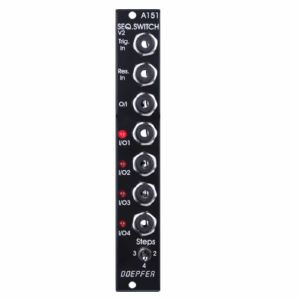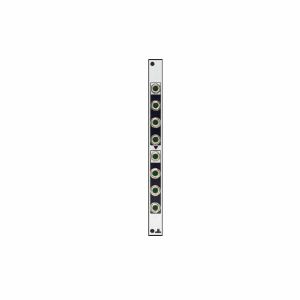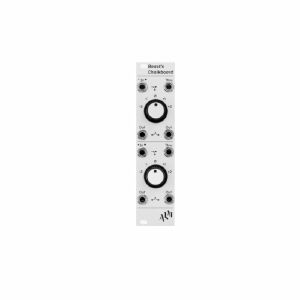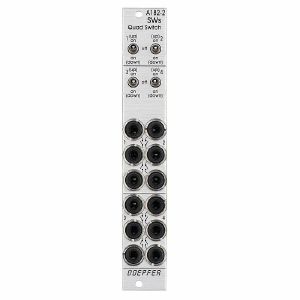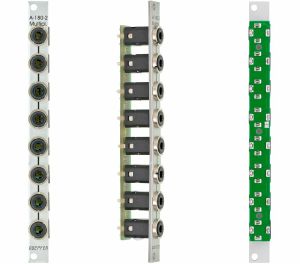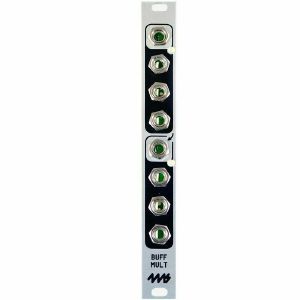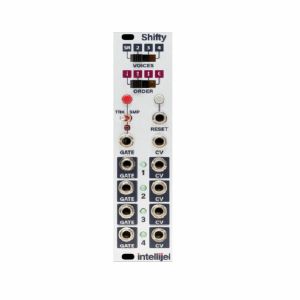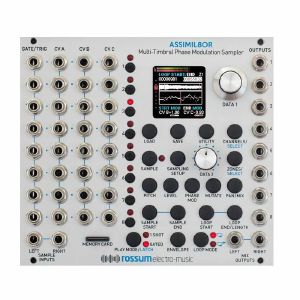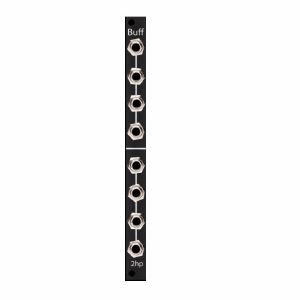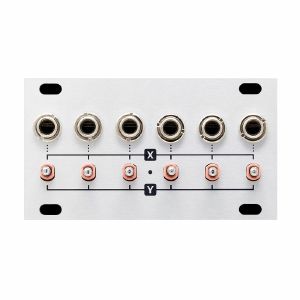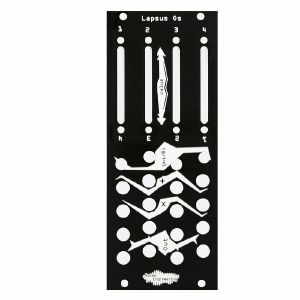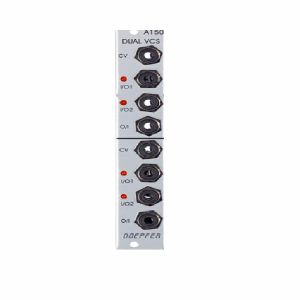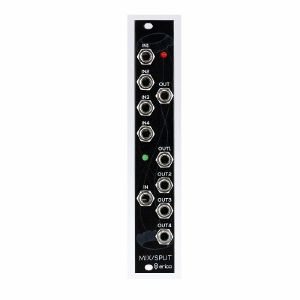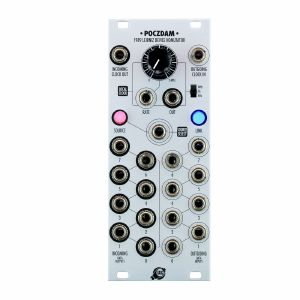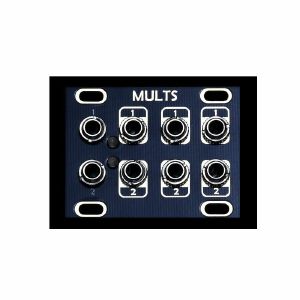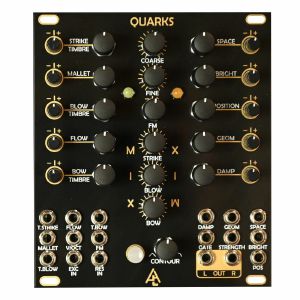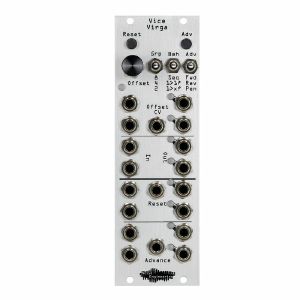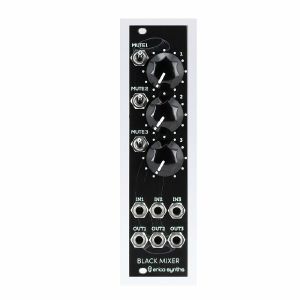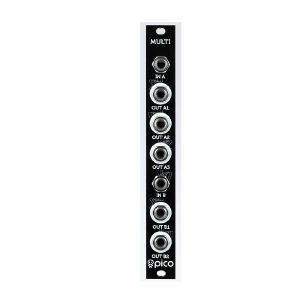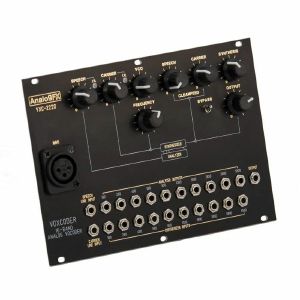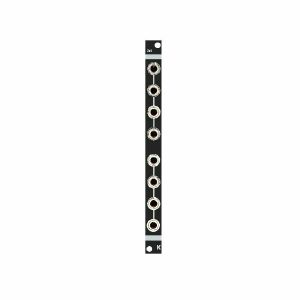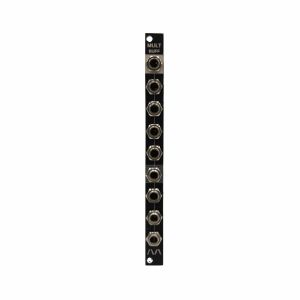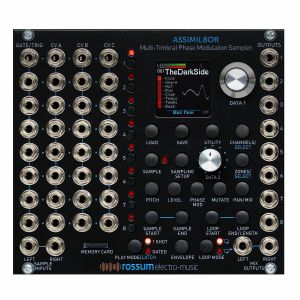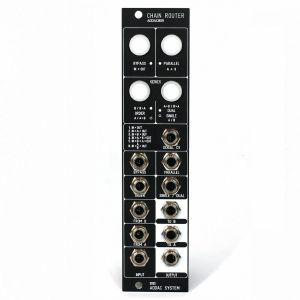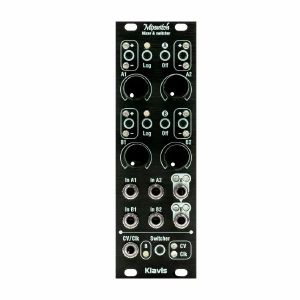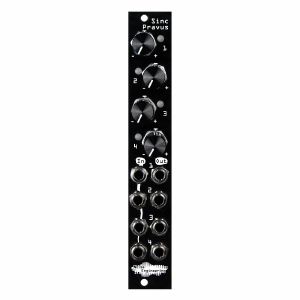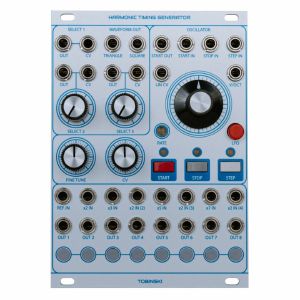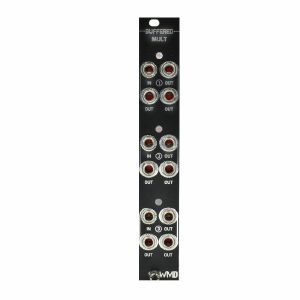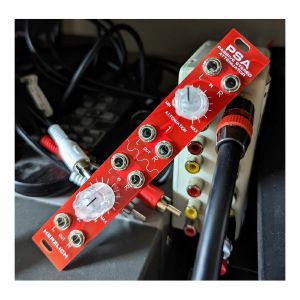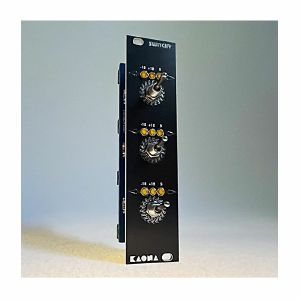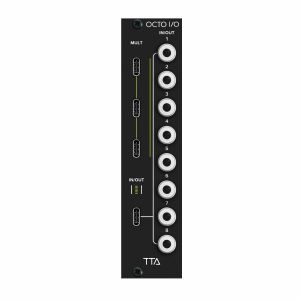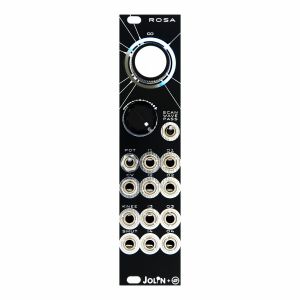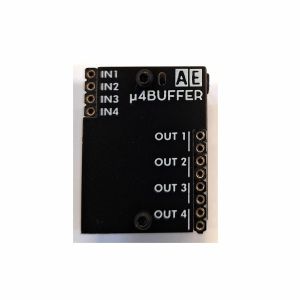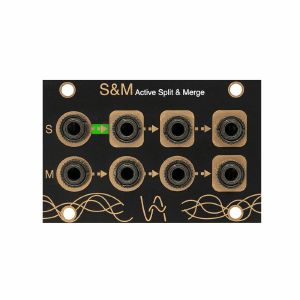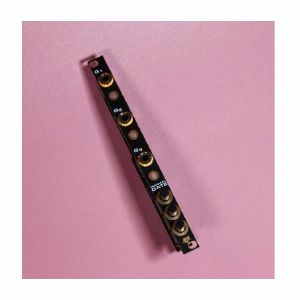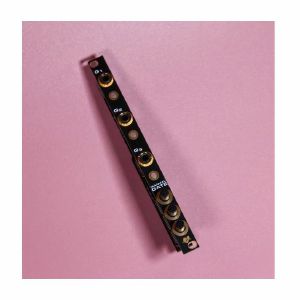Filter
Featured
Price
Tags
27
Multiple module
13
Switch module
11
Utility module
5
Mixer module
3
Attenuator module
3
Controller module
3
Oscillator module
2
CV modulation module
2
Clock generator module
2
Drum module
2
Function generator module
2
LFO module
2
Sampling module
1
Clock modulator module
1
Effects module
1
Expander module
1
Filter module
1
Noise module
1
Pitch shifter pedal
1
Power module
1
Sample & hold module
1
Sequencer module
Synth modules
The Eurorack modular synth format is one of the most exciting areas of music technology. Pioneered by Doepfer, there are now hundreds of brands offering compatible modules of all varieties. You can combine your choice of the best oscillators, filters and much more in order to create a unique, bespoke synth setup which perfectly suits your needs.
Eurorack modules offer the biggest range of options you can imagine, from basic analogue modules which replicate the sound of classic vintage synths, through to digital modules which allow you to explore completely new approaches to making music.
Whether you’re a beginner or a more experienced modular head, you can take your pick of the best modules from leading brands including Mutable Instruments and ALM Busy Circuits.
Our range also includes accessories, cases, patch cables and much more, allowing you to build and customise your perfect modular synth setup.

Artikel 1 bis 38 von 38 auf Seite 1 von 1 anzeigen
Doepfer A-151v Quad Sequential Switch Vintage Edition Module (black) (CV processor synth module)
Cat: 684462 Rel: 22 May 18
Electronic switch with up to four steps - 4HP
Notes: Module A-151 (Quad Sequential Switch) is like an electronic four-position rotary switch.
It includes trigger and reset inputs, four in/outputs, and a common out/input. Each time a pulse is received at the trigger input socket, the common out/input is connected to the next in/output. After the fourth in/output, the next trigger makes it step back to the first again, and so on. A positive pulse at the reset input switches the out/input immediately back to the first in/output. Voltages in the range -8V...+8V at the O/I resp. I/O sockets can be processed by the module.
Four LED's indicate the active in/output (ie. the one that is connected to the out/input at any particular time).
… Read moreIt includes trigger and reset inputs, four in/outputs, and a common out/input. Each time a pulse is received at the trigger input socket, the common out/input is connected to the next in/output. After the fourth in/output, the next trigger makes it step back to the first again, and so on. A positive pulse at the reset input switches the out/input immediately back to the first in/output. Voltages in the range -8V...+8V at the O/I resp. I/O sockets can be processed by the module.
Four LED's indicate the active in/output (ie. the one that is connected to the out/input at any particular time).
2 in stock $67.18
Intellijel Buff Mult 1U Buffered Multiple Module (multiple synth module)
Cat: 643380 Rel: 27 Mar 17
Buffered multiple module in 1U
Notes: Dual 1 x 4 buffered mult (one audio or cv signal in with multiple buffered outputs).
The output of the first mult is normalled to the input of the second mult to create a 1×8 buffered mult.
… Read moreThe output of the first mult is normalled to the input of the second mult to create a 1×8 buffered mult.
1 in stock $48.15
Click for better price!
or call +44 20 7424 1960
quote 643380
quote 643380
Intellijel Buff Mult Buffered Multiple Module (multiple synth module)
Cat: 563563 Rel: 10 Mar 15
Buffered multiple synth module, 2HP wide
Notes: Dual 1 x 3 buffered mult (one audio or cv signal in with multiple buffered outputs).
The output of the first mult is normalled to the input of the second mult to create a 1×6 buffered mult
… Read moreThe output of the first mult is normalled to the input of the second mult to create a 1×6 buffered mult
4 in stock $70.54
Click for better price!
or call +44 20 7424 1960
quote 563563
quote 563563
Intellijel Mult Passive Multiple Module (multiple/dual/stereo synth module)
Cat: 563665 Rel: 11 Mar 15
Passive multiple synth module, 2HP wide
Notes: Dual 4-way passive mult (one audio or cv signal in with multiple unbuffered outputs)
On the back of the pcb is a pair of solder points marked as "link". You can connect these (with a solder blob or small jumper wire) to turn the mult into a single 8 channel Mult instead of 2 x 4 channel.
… Read moreOn the back of the pcb is a pair of solder points marked as "link". You can connect these (with a solder blob or small jumper wire) to turn the mult into a single 8 channel Mult instead of 2 x 4 channel.
3 in stock $35.83
ALM Beast's Chalkboard Octave Switcher/Voltage Adder Module (utility/multiple synth module)
Cat: 584248 Rel: 15 Apr 16
Dual channel stepped voltage source and adder synth module - 6HP wide
Notes: 'Beast's Chalkboard' is dual channel stepped voltage source and adder for your eurorack modular synthesizer system. It primarily is intended as a dual octave switcher for VCO's but has many other uses including sequence transposition, FM ratio creation, buffered CV distribution and VCO calibration.
Technical Specifications:
Supply: +/-12V (Reverse voltage & polyfuse protection)
Current Draw: ~30ma
Size: 6 HP
Depth: 22mm (including power header)
Offset Error: +/- 10mV
… Read moreTechnical Specifications:
Supply: +/-12V (Reverse voltage & polyfuse protection)
Current Draw: ~30ma
Size: 6 HP
Depth: 22mm (including power header)
Offset Error: +/- 10mV
2 in stock $120.94
Click for better price!
or call +44 20 7424 1960
quote 584248
quote 584248
Doepfer A-182-2 Quad Passive Switch Module (silver, slim line series) (switch synth module)
Cat: 731951 Rel: 11 Jun 19
Quad passive switch - 4HP
Notes: A-182-2 is a simple passive module that contains four changeover switches, which are used to connect or disconnect the sockets of the corresponding socket triplet:
- In the upper position of the switch the upper socket of the corresponding socket triplet is connected to the centre socket
- In the lower position of the switch the lower socket of the corresponding socket triplet is connected to the centre socket
- In the centre position of the switch the sockets are not connected
Each unit of the module can be used to switch between two signals or to interrupt/connect a signal. In the last case the third socket of the triplet is not used.
The module is fully passive and both audio or control signals can be switched.
… Read more- In the upper position of the switch the upper socket of the corresponding socket triplet is connected to the centre socket
- In the lower position of the switch the lower socket of the corresponding socket triplet is connected to the centre socket
- In the centre position of the switch the sockets are not connected
Each unit of the module can be used to switch between two signals or to interrupt/connect a signal. In the last case the third socket of the triplet is not used.
The module is fully passive and both audio or control signals can be switched.
1 in stock $67.18
Click for better price!
or call +44 20 7424 1960
quote 731951
quote 731951
Doepfer A-180-2 Passive Multiple Module (silver) (dual/stereo/multiple/utility module)
Cat: 577779 Rel: 14 Jun 19
Passive multi-port distributor - 2HP
Notes: 2HP narrow version of the A-180 multiples module. It is a passive signal splitter suitable for audio or CVs. Two sets of four jacks are interconnected, by placing a solder bridge you can connect all eight jacks.
Dimensions
2 HP
18 mm deep
Current Draw
Module does not draw current
… Read moreDimensions
2 HP
18 mm deep
Current Draw
Module does not draw current
4 in stock $37.24
4ms Buff Mult Two Independent 1 To 3 Buffered Mutliples Module (silver) (multiple/video synth module)
Cat: 589492 Rel: 09 Dec 15
Buffered multiple synthesiser module with LED indicators - 3HP wide
Notes: The Buff Mult is a buffered multiple with LED indicators to show positive and negative voltages. Using wide bandwidth opamps, it functions as a dual 1-to-3 or a single 1-to-6 mult for audio, video, or CV signals.
… Read more2 in stock $72.79
Click for better price!
or call +44 20 7424 1960
quote 589492
quote 589492
Intellijel Shifty Voice Allocator/Note Hocketing/Analogue Shift Register Module (sample & hold/sequencer/shift register synth module)
Cat: 643384 Rel: 27 Mar 17
Voice allocator, note hocketing & analog shift register module - 6HP
Notes: The Shifty is essentially a combination of four sample and hold stages, a sequential gate and sequencer controller. This collection of functions allows for some specific and useful utility application.
One of the primary uses for Shifty is to take a monophonic sequence source and route each new note of the sequence to up to four different synthesizer voices in a specific pattern. In this way you can create pseudo polyphonic sequences since each voice can be triggered to play and sustain while the next voice int the sequence gets triggered. Another term for this is hocketing.
The other main application of the Shifty is to function as an Analog Shift Register. In this mode each new gate input received causes the current set of pitches to be shifted to new output locations as a new one is added and the oldest one is replaced. This can be an interesting way to create chords that are up to four stacked notes when used with a pitch sequence source that has a harmonious series of notes (e.g. a pentatonic scale works really well). Even just using two of the outputs will yield very interesting melodic interplay and is an excellent way to make a simple sequence much more complex and interesting.
In a more basic way the Shifty could be used as a simple Sample/Track and Hold module or as a sequential gate.
… Read moreOne of the primary uses for Shifty is to take a monophonic sequence source and route each new note of the sequence to up to four different synthesizer voices in a specific pattern. In this way you can create pseudo polyphonic sequences since each voice can be triggered to play and sustain while the next voice int the sequence gets triggered. Another term for this is hocketing.
The other main application of the Shifty is to function as an Analog Shift Register. In this mode each new gate input received causes the current set of pitches to be shifted to new output locations as a new one is added and the oldest one is replaced. This can be an interesting way to create chords that are up to four stacked notes when used with a pitch sequence source that has a harmonious series of notes (e.g. a pentatonic scale works really well). Even just using two of the outputs will yield very interesting melodic interplay and is an excellent way to make a simple sequence much more complex and interesting.
In a more basic way the Shifty could be used as a simple Sample/Track and Hold module or as a sequential gate.
1 in stock $185.90
Rossum Electro-Music Assimil8or Multi-Timbral Phase Modulation Sampler Module(silver) (sampling/CV modulation/digital/drum/dual/stereo/multiple/LFO synth module)
Cat: 676299 Rel: 12 Apr 18
CV/Gate-controllable sampler - 28HP
Notes: ***Now featuring Assimil8or Software Version 2.0! Available to download here: http://www.rossum-electro.com/products/assimil8or/
The ASSIMIL8OR is a CV/Gate-controllable sampler with eight independent channels. Each channel is not only its own voice, but also has a separate audio output and a gate/trigger and three CV inputs. Given ever get two sample inputs and main outputs. Thus, Stereo Sampling and playback is possible. Mixed operation of stereo or mono is possible and is limited only by the maximum number of eight channels or parts.
The ASSIMIL8OR works with high-quality 24-bit AD and DA converters. Internally, however, sample and bit rate for lo-fi sound can be lowered, the latter is even CV-controllable. The samples can also be otherwise manipulated in many ways. Thus, the phase of a sample via CV or a different sample can be modulated. Likewise, the loop points can be controlled and the sample can be traversed with CV control (scrubbing), whereby wavetable similar effects could be achieved. The following parameters can be addressed via the gate / trigger and CV inputs:
- Pitch
- Level
- Bit Depth
- Phase Modulation
- Pan
- Scrub
- Sample Start
- Sample Length
- Loop Start
- Loop Length
- Release Decay
Samples and presets are stored on an SD card, which is easily accessible plugged into the module front.
… Read moreThe ASSIMIL8OR is a CV/Gate-controllable sampler with eight independent channels. Each channel is not only its own voice, but also has a separate audio output and a gate/trigger and three CV inputs. Given ever get two sample inputs and main outputs. Thus, Stereo Sampling and playback is possible. Mixed operation of stereo or mono is possible and is limited only by the maximum number of eight channels or parts.
The ASSIMIL8OR works with high-quality 24-bit AD and DA converters. Internally, however, sample and bit rate for lo-fi sound can be lowered, the latter is even CV-controllable. The samples can also be otherwise manipulated in many ways. Thus, the phase of a sample via CV or a different sample can be modulated. Likewise, the loop points can be controlled and the sample can be traversed with CV control (scrubbing), whereby wavetable similar effects could be achieved. The following parameters can be addressed via the gate / trigger and CV inputs:
- Pitch
- Level
- Bit Depth
- Phase Modulation
- Pan
- Scrub
- Sample Start
- Sample Length
- Loop Start
- Loop Length
- Release Decay
Samples and presets are stored on an SD card, which is easily accessible plugged into the module front.
1 in stock $1,099.75
Click for better price!
or call +44 20 7424 1960
quote 676299
quote 676299
2hp Buff Buffered Multiple Module (black) (multiple/utility synth module)
Cat: 725420 Rel: 19 Mar 19
2HP Eurorack buffered mult module - black
Notes: The 2hp Buff is a buffered multiple capable of splitting an input signal to multiple outputs. Due to its active architecture, inputs retain their full integrity as they are copied to multiple destinations. One input signal can be copied to six outputs, or two inputs can be copied to three outputs each. The Buff is especially great for splitting pitch or audio signals where signal integrity is critical. Keep your signals in shape with Buff.
… Read more 1 in stock $87.92
Click for better price!
or call +44 20 7424 1960
quote 725420
quote 725420
Intellijel Switched Mult 1U Chainable Passive Switched Multiplier Module (multiple synth module)
Cat: 821573 Rel: 26 Apr 21
Eurorack multiple module
Notes: Switched mults come to Intellijel's space-saving 1U format, offering six jacks and two busses, routing signals between the two or muting them using three-position switches.
Supplier's Notes:
The Mult 1U takes one audio or CV signal input, and (mult)iplies to up to four outputs. Because the Mult is passive, it requires no power to operate. Multiply anything by four, twice.
A signal multiplier accepts an input signal and routes it to multiple outputs simultaneously. For example, you might want a sequencer's GATE to trigger two different envelopes - one to control volume and one to control filter frequency. In order to accomplish this, you need a signal multiplier.
In addition, each Switched Mult 1U features a pair of 3-pin Link connectors on the rear panel. These let you connect other 3-pin Link devices, such as an XY I/O 1U module, or even additional Switched Mult 1U modules (handy for distributing mults across the width of your case).
Width: 14HP
Depth: 18mm
Power: n/a (passive)
… Read moreSupplier's Notes:
The Mult 1U takes one audio or CV signal input, and (mult)iplies to up to four outputs. Because the Mult is passive, it requires no power to operate. Multiply anything by four, twice.
A signal multiplier accepts an input signal and routes it to multiple outputs simultaneously. For example, you might want a sequencer's GATE to trigger two different envelopes - one to control volume and one to control filter frequency. In order to accomplish this, you need a signal multiplier.
In addition, each Switched Mult 1U features a pair of 3-pin Link connectors on the rear panel. These let you connect other 3-pin Link devices, such as an XY I/O 1U module, or even additional Switched Mult 1U modules (handy for distributing mults across the width of your case).
Width: 14HP
Depth: 18mm
Power: n/a (passive)
1 in stock $47.88
Click for better price!
or call +44 20 7424 1960
quote 821573
quote 821573
Noise Engineering Lapsus Os 4-Channel Attenuverter/Attenuator Module (black) (attenuator synth module)
Cat: 836849 Rel: 18 Aug 21
Quad-channel attenuverter/attenuator and offset with faders
Notes: Performance-focussed four-channel attenuverter and offset module, with built-in voltage generator for 0-5v or i5v voltages. Simple but effective.
Supplier's Notes:
Lapsus Os is a four channel attenuator/attenuverter and offset. Designed with performance in mind, each channel can be set to either attenuate or attenuate/invert an incoming signal, adjust offset of an incoming signal, or with nothing patched to its input, generate a 0-5v or i5v offset. Switches on the back of the module invert the fader behavior, allowing for the module to be mounted in either direction, for further customization and ease of use.
Etymology
Lapsus -- from latin lapsus : 'sliding' Os -- from latin os 'bones'
"Translation: Dancing Corpse"
Interface
Faders 1-4: The main controls of LO. The LEDs in the faders show the CV that is being passed through. When in attenuverter mode, the LED will be off at 0, allowing each fader to easily be set near 0.
Offset inputs 1-4 (+): Sending a signal to these inputs adds an offset to the input, controlled by the fader and the mode switch.
Outputs: Each channel has a pair of identical outputs. If nothing is sent to either input of a channel, an offset will be generated and output here, useful for controlling parameters on other modules with a single fader.
Uni/Bi Switches 1-4: In the Unipolar position (left), the corresponding channel attenuates the input signal. In the Bipolar position (right), the upper half of the corresponding channel fader attenuates the input signal, the lower half of the fader inverts and attenuates the signal.
Attenuating/attenuverting inputs 1-4 (x): Sending a signal to these inputs attenuates/attenuverts the signal, depending on the position of the channel fader and switch.
Rear-board switches: Below, in red. Inverts the corresponding channel, allowing for creative mounting in either direction. Note that each channel must be switched independently to fully reverse the functionality.
Patch Tutorial
Patch 1: Set a channel switch to the left position and patch the outputs to CV inputs on another module (for instance, Loquelic Iteritas). The fader becomes an easy-to-use controller for those parameters. Patch the rest of the LO channels to other parameters in your system to create an expressive and intuitive interface.
Patch 2: Patch a CV signal (such as an LFO) into the attenuverting input of a channel. Set the channel switch to the right position, and patch the output to a bipolar CV input in your system. Tweak the fader to attenuvert and dial in the perfect amount of modulation on the fly.
Patch 3: In a case with four voices route each LO channel to the decay control for each voice. Use for centralized control over voicing.
Size: 10HP Eurorack
Depth .8 Inches
Power 2x5 Eurorack
+12 mA 60 mA
-12 mA 50 mA
Inputs: i10v
Outputs (without voltage applied):
Unipolar: 0-5v
Bipolar: i5v
… Read moreSupplier's Notes:
Lapsus Os is a four channel attenuator/attenuverter and offset. Designed with performance in mind, each channel can be set to either attenuate or attenuate/invert an incoming signal, adjust offset of an incoming signal, or with nothing patched to its input, generate a 0-5v or i5v offset. Switches on the back of the module invert the fader behavior, allowing for the module to be mounted in either direction, for further customization and ease of use.
Etymology
Lapsus -- from latin lapsus : 'sliding' Os -- from latin os 'bones'
"Translation: Dancing Corpse"
Interface
Faders 1-4: The main controls of LO. The LEDs in the faders show the CV that is being passed through. When in attenuverter mode, the LED will be off at 0, allowing each fader to easily be set near 0.
Offset inputs 1-4 (+): Sending a signal to these inputs adds an offset to the input, controlled by the fader and the mode switch.
Outputs: Each channel has a pair of identical outputs. If nothing is sent to either input of a channel, an offset will be generated and output here, useful for controlling parameters on other modules with a single fader.
Uni/Bi Switches 1-4: In the Unipolar position (left), the corresponding channel attenuates the input signal. In the Bipolar position (right), the upper half of the corresponding channel fader attenuates the input signal, the lower half of the fader inverts and attenuates the signal.
Attenuating/attenuverting inputs 1-4 (x): Sending a signal to these inputs attenuates/attenuverts the signal, depending on the position of the channel fader and switch.
Rear-board switches: Below, in red. Inverts the corresponding channel, allowing for creative mounting in either direction. Note that each channel must be switched independently to fully reverse the functionality.
Patch Tutorial
Patch 1: Set a channel switch to the left position and patch the outputs to CV inputs on another module (for instance, Loquelic Iteritas). The fader becomes an easy-to-use controller for those parameters. Patch the rest of the LO channels to other parameters in your system to create an expressive and intuitive interface.
Patch 2: Patch a CV signal (such as an LFO) into the attenuverting input of a channel. Set the channel switch to the right position, and patch the output to a bipolar CV input in your system. Tweak the fader to attenuvert and dial in the perfect amount of modulation on the fly.
Patch 3: In a case with four voices route each LO channel to the decay control for each voice. Use for centralized control over voicing.
Size: 10HP Eurorack
Depth .8 Inches
Power 2x5 Eurorack
+12 mA 60 mA
-12 mA 50 mA
Inputs: i10v
Outputs (without voltage applied):
Unipolar: 0-5v
Bipolar: i5v
1 in stock $229.58
Doepfer A-150 Dual Voltage Controlled Switch Module (silver) (switch synth module)
Cat: 745778 Rel: 10 Sep 19
Two independent voltage controlled switches in one module - 4HP
Notes: Module A-150-1 (Dual VCS) contains two separate voltage-controlled switches.
Each switch has a control voltage input, a common Out / Input, and two In / Outputs. The switches are bi-directional: they can work in both directions, so can connect one input to either of two outputs, or either of two inputs to one output. Voltages in the range -8V...+8V at the O/I resp. I/O sockets can be processed by the module.
Two LEDs show which in / output is active (i.e. which is connected to the common out / input).
… Read moreEach switch has a control voltage input, a common Out / Input, and two In / Outputs. The switches are bi-directional: they can work in both directions, so can connect one input to either of two outputs, or either of two inputs to one output. Voltages in the range -8V...+8V at the O/I resp. I/O sockets can be processed by the module.
Two LEDs show which in / output is active (i.e. which is connected to the common out / input).
1 in stock $71.67
Click for better price!
or call +44 20 7424 1960
quote 745778
quote 745778
Erica Synths Black Mixer/Splitter v2 Audio/CV Mixer & Multiple Module (multiple/mixer module)
Cat: 826616 Rel: 17 Jun 21
Input mixer/output signal splitter module - 4HP
Notes: Introducing a four independently buffered input mixer and a buffered output signal splitter, in one module!
Erica Synths Black Mixer/Splitter V2 is an advanced replacement for stackable patchcables.
Everyone who knows a bit more about electronics will point out that stackable patchcables are not a really wise choice for such sensitive things as musical instruments because they mechanically connect electrical signals that at best can cause undesired modulations or even damage the modules.
Erica Black series are high-end modules with unique functionality. Only the highest quality components are used and all inputs and outputs are protected against undesired overvoltage. When designing the Black Series, design and usability were prioritised first. Big knobs are assigned to functions that make difference in sound. Together the Erica Black series are a range of modules that make an entire synthesizer.
Technical specifications:
Input signal level: -10V - +10V
Power consumption: +25mA, -25mA
Module width: 4HP
Module depth: 25mm
… Read moreErica Synths Black Mixer/Splitter V2 is an advanced replacement for stackable patchcables.
Everyone who knows a bit more about electronics will point out that stackable patchcables are not a really wise choice for such sensitive things as musical instruments because they mechanically connect electrical signals that at best can cause undesired modulations or even damage the modules.
Erica Black series are high-end modules with unique functionality. Only the highest quality components are used and all inputs and outputs are protected against undesired overvoltage. When designing the Black Series, design and usability were prioritised first. Big knobs are assigned to functions that make difference in sound. Together the Erica Black series are a range of modules that make an entire synthesizer.
Technical specifications:
Input signal level: -10V - +10V
Power consumption: +25mA, -25mA
Module width: 4HP
Module depth: 25mm
2 in stock $73.08
Xaoc Devices Poczdam 1989 Leibniz Device Komutator Module (clock generator synth module)
Cat: 894984 Rel: 14 Oct 22
Poczdam is a binary data routing solution for the Xaoc Leibniz Subsystem.
Notes: Part of Xaoc's Leibniz subsystem, which processes signals and voltages by manipulating binary 8-bit numbers, the Poczdam allows switching between two data sources.
Supplier's Notes:
Poczdam is a binary data routing solution for the Xaoc Leibniz Subsystem. It facilitates manual and remote switching between two Leibniz data sources, modifying individual bits of the data stream, and re-clocking the data with its onboard voltage-controlled wideband oscillator or any external clock signal. Poczdam is particularly useful within complex Leibniz setups where the user needs to reconfigure the data flow between multiple modules. However, it can also be employed in small creative patches, e.g., for waveform splicing, disrupting rhythmic loops, or generating digital chaos.
To better understand the device and avoid common pitfalls, it is strongly advised to read through the entire user manual before use.
Component of the Leibniz Binary Subsystem
Routing Leibniz data
Reclocking Leibniz data
Additional CV clock generator (up to 2MHz)
6hp, 30mm deep
Current draw: +20mA/-10mA
Reverse power protection
The high quality Coal Mine black panels are available for all Xaoc Devices modules. Sold separately. Ask your favourite retailer.
Drezno is the input/output front-end of the system, consisting of an analogue-to-digital converter (ADC) and a digital-to-analogue converter (DAC), that alone can be used for manipulating analogue signals and voltages based on their binary representation.
Lipsk is a binary logic processing expander module that can flip (invert) individual bits of the digital signal representation. There are more Leibniz Binary Subsystem elements coming, with specialized and advanced sets of features.
Jena is a digital module that may be used as a flexible waveshaper for CV and audio signals, a wavetable oscillator, a Walsh function generator, or a rhythm generator.
Erfurt is a bi-directional digital counter, frequency divider. It has multiple applications: the output of the counter may be used as a phase source driving a digital wavetable, connected to other Leibniz modules it may scan waveshapes in Jena, produce stepped voltages useful for making interesting glissandi with Drezno and any VCO, generate gate patterns animating the spectrum of Odessa harmonic banks, spawn pseudo-chaotic sequences when fed back to Lipsk, etc.
… Read moreSupplier's Notes:
Poczdam is a binary data routing solution for the Xaoc Leibniz Subsystem. It facilitates manual and remote switching between two Leibniz data sources, modifying individual bits of the data stream, and re-clocking the data with its onboard voltage-controlled wideband oscillator or any external clock signal. Poczdam is particularly useful within complex Leibniz setups where the user needs to reconfigure the data flow between multiple modules. However, it can also be employed in small creative patches, e.g., for waveform splicing, disrupting rhythmic loops, or generating digital chaos.
To better understand the device and avoid common pitfalls, it is strongly advised to read through the entire user manual before use.
Component of the Leibniz Binary Subsystem
Routing Leibniz data
Reclocking Leibniz data
Additional CV clock generator (up to 2MHz)
6hp, 30mm deep
Current draw: +20mA/-10mA
Reverse power protection
The high quality Coal Mine black panels are available for all Xaoc Devices modules. Sold separately. Ask your favourite retailer.
Drezno is the input/output front-end of the system, consisting of an analogue-to-digital converter (ADC) and a digital-to-analogue converter (DAC), that alone can be used for manipulating analogue signals and voltages based on their binary representation.
Lipsk is a binary logic processing expander module that can flip (invert) individual bits of the digital signal representation. There are more Leibniz Binary Subsystem elements coming, with specialized and advanced sets of features.
Jena is a digital module that may be used as a flexible waveshaper for CV and audio signals, a wavetable oscillator, a Walsh function generator, or a rhythm generator.
Erfurt is a bi-directional digital counter, frequency divider. It has multiple applications: the output of the counter may be used as a phase source driving a digital wavetable, connected to other Leibniz modules it may scan waveshapes in Jena, produce stepped voltages useful for making interesting glissandi with Drezno and any VCO, generate gate patterns animating the spectrum of Odessa harmonic banks, spawn pseudo-chaotic sequences when fed back to Lipsk, etc.
2 in stock $180.30
After Later Audio Mult 1U Buffered Multiple Module (multiple synth module)
Cat: 805156 Rel: 14 Jan 21
Buffered/active multiple module
Notes: Mult 1U Intellijel Format
This is a buffered/active mult with LED indicator. You get two channels of 1 to 3 multiples within a 2HP module. The output of channel 1 is normalled to channel 2 so it can also be treated as a 1 to 6 multiple as well.
Active vs Passive mults:
With a passive mult you are effectively just plugging multiple things into the same jacks. This will often cause some voltage drop in each of the signals. With an active (or buffered) mult you will not get any voltage drop from the original signal.
Comes with a black and gold panel, power cable and one year warranty.
Usage note:
The red stripe of the power ribbon cable goes towards the top of this module.
… Read moreThis is a buffered/active mult with LED indicator. You get two channels of 1 to 3 multiples within a 2HP module. The output of channel 1 is normalled to channel 2 so it can also be treated as a 1 to 6 multiple as well.
Active vs Passive mults:
With a passive mult you are effectively just plugging multiple things into the same jacks. This will often cause some voltage drop in each of the signals. With an active (or buffered) mult you will not get any voltage drop from the original signal.
Comes with a black and gold panel, power cable and one year warranty.
Usage note:
The red stripe of the power ribbon cable goes towards the top of this module.
1 in stock $63.55
Click for better price!
or call +44 20 7424 1960
quote 805156
quote 805156
After Later Audio Quarks Elements Redesigned Module (filter/multiple/oscillator synth module)
Cat: 910113 Rel: 21 Nov 22
A 22hp version of Mutable Instruments Elements.
Notes: A 22hp version of Mutable Instruments Elements. It is functionally equivalent and therefore runs all firmware options and having identical sound characteristics. This version is great compromise between the tight spacing of Atom and full size original, which is a bit large.
Width: 22hp
12V: 130mA
-12V: 10mA
Module power connector can be connected either way on the module side.
… Read moreWidth: 22hp
12V: 130mA
-12V: 10mA
Module power connector can be connected either way on the module side.
2 in stock $277.73
Click for better price!
or call +44 20 7424 1960
quote 910113
quote 910113
Noise Engineering Vice Virga Sequential & Addressable Switch Module (silver) (switch/utility module)
Cat: 849289 Rel: 04 Nov 21
8-input, 8-output sequential & addressable switch module - 8HP
Notes: 8-input, 8-output sequential/addressable switch with manual, trigger, and CV control, plus three grouping options, multiple switching directions, and randomization.
Vice Virga is an 8-input, 8-output sequential/addressable switch with a plethora of features and extensive patchability. Vice Virga can be configured as a single 8-channel switch, two 4-channel switches, or four 2-channel switches. Equal parts automated patch arranger and performance tool, Vice Virga has loads of switching control options. Whether you want to chain sequencers, swap outputs on an oscillator, remix a trigger pattern, or mix up every connection in a patch just to see what happens, Vice Virga can do it!
Features:
Size and power:
8HP Eurorack
+12v: 40mA
-12v: 20mA
Vice i from Latin for "alternately"
Virga i from Latin for "switch"
"Alternating Switch"
… Read moreVice Virga is an 8-input, 8-output sequential/addressable switch with a plethora of features and extensive patchability. Vice Virga can be configured as a single 8-channel switch, two 4-channel switches, or four 2-channel switches. Equal parts automated patch arranger and performance tool, Vice Virga has loads of switching control options. Whether you want to chain sequencers, swap outputs on an oscillator, remix a trigger pattern, or mix up every connection in a patch just to see what happens, Vice Virga can do it!
Features:
Size and power:
8HP Eurorack
+12v: 40mA
-12v: 20mA
Vice i from Latin for "alternately"
Virga i from Latin for "switch"
"Alternating Switch"
2 in stock $306.85
Click for better price!
or call +44 20 7424 1960
quote 849289
quote 849289
Erica Synths Black Mute Mixer Audio Mixer Module With Mutes (mixer/multiple/switch module)
Cat: 826611 Rel: 05 May 21
Audio mixer module with mutes - 6HP
Notes: Erica Synths Black Mixer is compact, high quality audio mixer with bonus features - mute switch on each input and three buffered outputs. This allows you to add audio signals to your mix instantly and in exactly right level, plus you can send signals to several post-mixer devices simultaneously, for example, split the output signal to LP and HP VCFs and create advanced bandpass and notch filters.
Technical specifications:
Max input level: -10V - +10V
Mixer gain: 1
Power consumption : +8mA, -8mA
Module width: 6HP
Module depth: 25mm
… Read moreTechnical specifications:
Max input level: -10V - +10V
Mixer gain: 1
Power consumption : +8mA, -8mA
Module width: 6HP
Module depth: 25mm
1 in stock $85.67
Click for better price!
or call +44 20 7424 1960
quote 826611
quote 826611
Erica Synths Pico Multi 2 Buffered Multiple Module (multiple synth module)
Cat: 807936 Rel: 12 Jan 21
Active buffered multiple module - 3HP
Notes: Small but perfectly formed, a clever multiple from Erica's compact Pico range. Active buffering to prevent signal loss and two-part A and B setup for 1-3 plus 1-2 or 1-5 configuration.
Supplier's Notes:
Erica Synths Pico Multi is an advanced replacement for stackable patchcables - it's highly accurate active buffered multiple that will work for signal splitting in any circuit, including driving several VCOs in tune from one CV source.
Two independent active buffered multiples 1-3+1-2 or 1-5 configuration.
Technical specifications:
Max input level: -10V - +10V
Power consumption: +20mA, -14mA
Module width: 3HP
Module depth: 35mm
… Read moreSupplier's Notes:
Erica Synths Pico Multi is an advanced replacement for stackable patchcables - it's highly accurate active buffered multiple that will work for signal splitting in any circuit, including driving several VCOs in tune from one CV source.
Two independent active buffered multiples 1-3+1-2 or 1-5 configuration.
Technical specifications:
Max input level: -10V - +10V
Power consumption: +20mA, -14mA
Module width: 3HP
Module depth: 35mm
1 in stock $69.99
Click for better price!
or call +44 20 7424 1960
quote 807936
quote 807936
AnalogFX VXC-2220 10-Band Analogue Vocoder Module (black) (effect synth module)
Cat: 865009 Rel: 25 May 22
The VXC-2220 is a 10-band analogue vocoder with patch-bay for each individual filter section.
Notes: Very nice old-school vocoder for Eurorack, featuring a built-in mic pre-amp and full 10-band patch bay. Internal VCO and straightforward control setup help simplify operation.
Supplier's Notes:
The VXC-2220 is an 10-band analogue vocoder with patch-bay for each individual filter section. VXC-2220 vocoder is based on the iconic classics 222 vocoder. For stand alone usage the VXC-2220 is equipped with an internal oscillator generating saw and pulse waves form C1 to C6. A simple and efficient vocoder.
Specifications
Microphone input for speech signal
Line input for speech signal
Line input for carrier signal
Input level control for speech and carrier signal
Output level control
Line output
10-Band analyzer outputs
10-Band synthesizer input
Internal VCO (1 semi-nut step size);
* Saw wave (C1 - C6)
* 3x 10% Pulse wave (C1+C2+C3 - C4+C5+C6 )
* White noise
- Synthesis for 's' and 't' sounds
- Feed-trough level control for speech and carrier channel
- Bypass switch
- 10pin power connector (+/-12V)
Dimensions:
(36HP) 128,5×182.5mm (depth: ca. 35mm incl. power connector)
Power Consumption:
+12V = 125mA
-12V = -125mA
… Read moreSupplier's Notes:
The VXC-2220 is an 10-band analogue vocoder with patch-bay for each individual filter section. VXC-2220 vocoder is based on the iconic classics 222 vocoder. For stand alone usage the VXC-2220 is equipped with an internal oscillator generating saw and pulse waves form C1 to C6. A simple and efficient vocoder.
Specifications
Microphone input for speech signal
Line input for speech signal
Line input for carrier signal
Input level control for speech and carrier signal
Output level control
Line output
10-Band analyzer outputs
10-Band synthesizer input
Internal VCO (1 semi-nut step size);
* Saw wave (C1 - C6)
* 3x 10% Pulse wave (C1+C2+C3 - C4+C5+C6 )
* White noise
- Synthesis for 's' and 't' sounds
- Feed-trough level control for speech and carrier channel
- Bypass switch
- 10pin power connector (+/-12V)
Dimensions:
(36HP) 128,5×182.5mm (depth: ca. 35mm incl. power connector)
Power Consumption:
+12V = 125mA
-12V = -125mA
1 in stock $525.24
Click for better price!
or call +44 20 7424 1960
quote 865009
quote 865009
Klavis 2x4 Passive Multiple Module (black) (multiple synth module)
Cat: 920077 Rel: 13 Jan 23
A passive multiple that fits nicely with the Klavis range.
Notes: A passive multiple that fits nicely with the Klavis range.
… Read more1 in stock $33.58
Morphor Mult Buffered Multiple Module (multiple synth module)
Cat: 947098 Rel: 19 Oct 23
Buffered multiple module with up to 8 outputs in 2HP.
Notes: A (buffered) mult is an essential item in every rack. This buffered DC-coupled module will fulfill all your audio and CV multiplying needs.
With a little switch on the back the module can be configured in two different modes.
The 1-to-8 mode speaks for itself, offering eight identical copies of your input signal.
The double mode offers a 1-to-4 and 1-to-3 buffered multiple with the first input getting normalised to all output jacks if the second input stays unused.
Weight: 27 g
Dimensions: 128.5 × 9.8 × 30 mm
Width: 2 HP
… Read moreWith a little switch on the back the module can be configured in two different modes.
The 1-to-8 mode speaks for itself, offering eight identical copies of your input signal.
The double mode offers a 1-to-4 and 1-to-3 buffered multiple with the first input getting normalised to all output jacks if the second input stays unused.
Weight: 27 g
Dimensions: 128.5 × 9.8 × 30 mm
Width: 2 HP
1 in stock $77.27
Click for better price!
or call +44 20 7424 1960
quote 947098
quote 947098
Rossum Electro-Music Assimil8or Multi-Timbral Phase Modulation Sampler Module (black) (sampling/CV modulation/digital/drum/dual/stereo/multiple/LFO module)
Cat: 996331 Rel: 15 Apr 24
multi-timbral phase modulation sampler module - 28HP
Notes: Sampler legend Dave Rossum's ultra-powerful Assimil8or module gets a black makeover. Eight-channel multi-timbral design with extensive CV control and clever sound manipulation options.
Supplier's Notes:
Designed to provide a powerful, flexible sampling engine for modular synthesis, the ASSIMIL8OR Multi-Timbral Phase Modulation Sampler module is the latest incarnation of Dave Rossum's decades-long pioneering of affordable professional sampling technology.
ASSIMIL8OR provides eight independent channels of sampling with sound quality that can range from extremely hi-fi to low fi, all with extensive real-time CV control.
Assimil8or Specifications
Sample memory
2,300 seconds at 48kHz mono, freely allocatable between the 8 channels
Sample rates
48kHZ, 96kHZ, 192kHZ
A/D & D/A
24 Bits
Internal processing
32 Bits
Latency
100 microseconds at the Mix Outputs
180 microseconds at the Individual Outputs
Inputs
Sample L/R
2x 3.5mm mono socket
100kO Input Impedance
Gate/Trigger 1-8
8x 3.5mm mono socket
100kO Input Impedance
1.6V threshold
Control Voltage A 1-8
8x 3.5mm mono socket
100kO Input Impedance
96 kHz sample rate
Anti-alias filtered to 20kHz bandwidth
Control Voltage B&C 1-8
16x 3.5mm mono socket
100kO Input Impedance
48 kHz sample rate
No anti-alias filtering
Outputs
Mix Outputs L/R
2x 3.5mm mono socket
1kO Impedance
Individual Outputs
8x 3.5mm mono socket
1kO Impedance
Power requirements: +/-12V via 16-pin, Doepfer-style connector
Current draw: 220mA +12V, 30mA -12V
Dimensions: 28HP (W); Panel to power connector (with connector plugged in) 25mm (D)
Supplied accessories:
1x Micro SD card
1x 16-pin, Doepfer-style cable
4x M3 screws
4x M2.5 screws
4x Nylon washers
1x Quickstart Guide
… Read moreSupplier's Notes:
Designed to provide a powerful, flexible sampling engine for modular synthesis, the ASSIMIL8OR Multi-Timbral Phase Modulation Sampler module is the latest incarnation of Dave Rossum's decades-long pioneering of affordable professional sampling technology.
ASSIMIL8OR provides eight independent channels of sampling with sound quality that can range from extremely hi-fi to low fi, all with extensive real-time CV control.
Assimil8or Specifications
Sample memory
2,300 seconds at 48kHz mono, freely allocatable between the 8 channels
Sample rates
48kHZ, 96kHZ, 192kHZ
A/D & D/A
24 Bits
Internal processing
32 Bits
Latency
100 microseconds at the Mix Outputs
180 microseconds at the Individual Outputs
Inputs
Sample L/R
2x 3.5mm mono socket
100kO Input Impedance
Gate/Trigger 1-8
8x 3.5mm mono socket
100kO Input Impedance
1.6V threshold
Control Voltage A 1-8
8x 3.5mm mono socket
100kO Input Impedance
96 kHz sample rate
Anti-alias filtered to 20kHz bandwidth
Control Voltage B&C 1-8
16x 3.5mm mono socket
100kO Input Impedance
48 kHz sample rate
No anti-alias filtering
Outputs
Mix Outputs L/R
2x 3.5mm mono socket
1kO Impedance
Individual Outputs
8x 3.5mm mono socket
1kO Impedance
Power requirements: +/-12V via 16-pin, Doepfer-style connector
Current draw: 220mA +12V, 30mA -12V
Dimensions: 28HP (W); Panel to power connector (with connector plugged in) 25mm (D)
Supplied accessories:
1x Micro SD card
1x 16-pin, Doepfer-style cable
4x M3 screws
4x M2.5 screws
4x Nylon washers
1x Quickstart Guide
1 in stock $1,078.48
Click for better price!
or call +44 20 7424 1960
quote 996331
quote 996331
ADDAC System ADDAC809 Chain Router Module (black) (switch/utility synth module)
Cat: 883866 Rel: 13 Oct 22
ADDAC809 is a dynamic CV operated I/O router that allows one source (Audio or CV) to be routed through 2 different chains (of one or more modules) before being sent to an output.
Notes: ADDAC809 is a dynamic CV operated I/O router that allows one source (Audio or CV) to be routed through 2 different chains (of one or more modules) before being sent to an output.
Six routing patterns are allowed:
1. IN > OUT
2. IN > CHAIN A > OUT
3. IN > CHAIN B > OUT
4. IN > CHAIN A > CHAIN B > OUT
5. IN > CHAIN B > CHAIN A > OUT
6. IN > > OUT
A practical example is to have an audio source, a delay and a looper.
And the question: should the delay be placed before or after the looper? Sometimes you may need the delay to be before the looper as you may want to sample the audio with the delay or sample the pure audio source and apply the delay afterwards.
This small utility module solves this issue on the fly without having to repatch anything.
INPUTS & OUTPUTS
TO CHAIN B: Connect to your Chain B input
FROM CHAIN B: Connect to your Chain B output
TO CHAIN A: Connect to your Chain A input
FROM CHAIN A: Connect to your Chain A output
INPUT: Connect to your Input Source
OUTPUT: Connect to your Output Source
ROUTING PATTERNS
There are 2 ways to address the six routing patterns:
Buttons: using the frontpanel push buttons and/or dedicated trigger inputs to latch between 2 states.
BYPASS: Chooses between Pattern 1 and any other pattern
PARALLEL: Chooses between Pattern 6 and any other pattern
ORDER: Chooses the order A before B or B before A
DUAL/SINGLE: Chooses to use a Dual (A>B or B>A) or Single chain (A or B)
CV: The dedicated CV input expects a 0 to +5v input and allows to jump to the precise routing pattern using a specific voltage interval in increments of approx. 0.83V:
Pattern 1: 0v to 0.83v
Pattern 2: 0.83v to 1.66v
Pattern 3: 1.66v to 2.5v
Pattern 4: 2.5v to 3.33V
Pattern 5: 3.33v to 4.16V
Pattern 6: 4.16v to 5V
Tech Specs:
Width: 12 HP
Depth: 55mm
Current: 80mA +12V / 30mA -12V
… Read moreSix routing patterns are allowed:
1. IN > OUT
2. IN > CHAIN A > OUT
3. IN > CHAIN B > OUT
4. IN > CHAIN A > CHAIN B > OUT
5. IN > CHAIN B > CHAIN A > OUT
6. IN > > OUT
A practical example is to have an audio source, a delay and a looper.
And the question: should the delay be placed before or after the looper? Sometimes you may need the delay to be before the looper as you may want to sample the audio with the delay or sample the pure audio source and apply the delay afterwards.
This small utility module solves this issue on the fly without having to repatch anything.
INPUTS & OUTPUTS
TO CHAIN B: Connect to your Chain B input
FROM CHAIN B: Connect to your Chain B output
TO CHAIN A: Connect to your Chain A input
FROM CHAIN A: Connect to your Chain A output
INPUT: Connect to your Input Source
OUTPUT: Connect to your Output Source
ROUTING PATTERNS
There are 2 ways to address the six routing patterns:
Buttons: using the frontpanel push buttons and/or dedicated trigger inputs to latch between 2 states.
BYPASS: Chooses between Pattern 1 and any other pattern
PARALLEL: Chooses between Pattern 6 and any other pattern
ORDER: Chooses the order A before B or B before A
DUAL/SINGLE: Chooses to use a Dual (A>B or B>A) or Single chain (A or B)
CV: The dedicated CV input expects a 0 to +5v input and allows to jump to the precise routing pattern using a specific voltage interval in increments of approx. 0.83V:
Pattern 1: 0v to 0.83v
Pattern 2: 0.83v to 1.66v
Pattern 3: 1.66v to 2.5v
Pattern 4: 2.5v to 3.33V
Pattern 5: 3.33v to 4.16V
Pattern 6: 4.16v to 5V
Tech Specs:
Width: 12 HP
Depth: 55mm
Current: 80mA +12V / 30mA -12V
2 in stock $118.25
Klavis Mixwitch Mixer & CV/Clock-Controlled Switcher Module (black) (attenuator/mixer/polarizer/switch synth module)
Cat: 951655 Rel: 20 Jun 24
Mixer and CV/clock-controlled switcher module - 8HP.
Notes: Mixer & CV/clock-controlled Switcher
Focused versatility seems an oxymoron when describing the features that led to the design of the Mixwitch.
With only a pinch of mixing, inverting and controlled switching, Klavis Electronics brew up a plethora of combinations and uses.
This is voltage processing magic!
The Mixwitch design comes from a frustration with attenuvertors (bipolar attenuators-inverters) whose off (neutral) position is difficult to retrieve, especially in live situations.
Klavis went for a digitally-controlled analogue path where polarity inversion would be at the touch of a button. So, the usefulness of attenuating/inverting can be realized by turning the pot down, swiftly pressing the inversion button and reopening the level. The zero level is where you expect it, with the pot full down.
Once a clean polarity control was established, a mute function was added, offering the benefit of pre-adjusted pot settings ready to be activated at will.
The next step was to bring something extra, useful and creative. There are plenty of analogue switches controlled by a clock; but arbitrarily selecting an input with a voltage is less known. Having both control capabilities combined with Klavis' specific mixer features creates a unique fusion: welcome to the Mixwitch!
Dimensions
8 HP
25 mm deep
Current Draw
39 mA +12V
24 mA -12V
0 mA 5V
… Read moreFocused versatility seems an oxymoron when describing the features that led to the design of the Mixwitch.
With only a pinch of mixing, inverting and controlled switching, Klavis Electronics brew up a plethora of combinations and uses.
This is voltage processing magic!
The Mixwitch design comes from a frustration with attenuvertors (bipolar attenuators-inverters) whose off (neutral) position is difficult to retrieve, especially in live situations.
Klavis went for a digitally-controlled analogue path where polarity inversion would be at the touch of a button. So, the usefulness of attenuating/inverting can be realized by turning the pot down, swiftly pressing the inversion button and reopening the level. The zero level is where you expect it, with the pot full down.
Once a clean polarity control was established, a mute function was added, offering the benefit of pre-adjusted pot settings ready to be activated at will.
The next step was to bring something extra, useful and creative. There are plenty of analogue switches controlled by a clock; but arbitrarily selecting an input with a voltage is less known. Having both control capabilities combined with Klavis' specific mixer features creates a unique fusion: welcome to the Mixwitch!
Dimensions
8 HP
25 mm deep
Current Draw
39 mA +12V
24 mA -12V
0 mA 5V
1 in stock $148.94
Click for better price!
or call +44 20 7424 1960
quote 951655
quote 951655
Noise Engineering Sinc Pravus 4-Channel Offset Module With Adjustable Range (black) (multiple/quad/utility synth module)
Cat: 908143 Rel: 07 Nov 22
4-channel offset with adjustable range
Notes: Sinc Pravus is the Goldilocks of a quad offset in 4HP. Whether your CV ranges are too high or too low, Sinc Pravus is just right.
Use the back-panel switch to configure Sinc Pravus to either ±5 or ±10 volts. To use Sinc Pravus as a DC-voltage generator, just leave the input unpatched.
Each of Sinc Pravus's four channels are controlled by a dedicated potentiometer with an LED for monitoring signal outputs. The input jacks are normalled from top to bottom so it can offset the same signal by different amounts or simply act as a mult.
Sinc Pravus is a workhorse in 4 HP.
… Read moreUse the back-panel switch to configure Sinc Pravus to either ±5 or ±10 volts. To use Sinc Pravus as a DC-voltage generator, just leave the input unpatched.
Each of Sinc Pravus's four channels are controlled by a dedicated potentiometer with an LED for monitoring signal outputs. The input jacks are normalled from top to bottom so it can offset the same signal by different amounts or simply act as a mult.
Sinc Pravus is a workhorse in 4 HP.
1 in stock $123.75
Click for better price!
or call +44 20 7424 1960
quote 908143
quote 908143
Tobinski Harmonic Timing Generator Module (oscillator/wave multiple synth module)
Cat: 1073604 Rel: 16 Apr 25
The Harmonic Timing Generator is a versatile Eurorack module that combines advanced clock generation with harmonic waveform manipulation
Notes: Clock generation meets waveform manipulation in this analogue harmonic oscillator. Combine with the Tobinski sequencer and/or interpolating scanner modules for the best creative results.
Supplier's Notes:
The Harmonic Timing Generator is a versatile Eurorack module that combines advanced clock generation with harmonic waveform manipulation. Combined with the Tobinski Sequencer, the module is a great tool for rhythmic and sonic creativity in the modular system.
As a reference clock generator, the Harmonic Timing Generator produces a base frequency with analogue multipliers (x1 to x8) to generate complex timing signals. Three selectors provide manual or voltage-controlled frequency switching, offering flexibility for intricate sequencing patterns. An LFO mode enables slower clocking rates, ideal for driving sequencers or generating modulation sources.
When used with the Interpolating Scanner, the sawtooth outputs of the Harmonic Timing Generator are transformed into sine waves. This allows the module to function as a harmonic oscillator at audio rates or as a versatile modulation source in LFO mode. Its dual functionality ensures that it can adapt to a wide range of patching needs, from rhythm generation to rich harmonic exploration.
The Harmonic Timing Generator is a versatile and creative tool, offering rhythmic and harmonic possibilities that complement any modular synthesizer setup. Its integration with other Tobinski modules ensures a cohesive and expansive sonic palette.
Power consumption: 235mA at +12V and 176mA at -12V and 20mA at +5V
Depth: 27mm
18 HP
… Read moreSupplier's Notes:
The Harmonic Timing Generator is a versatile Eurorack module that combines advanced clock generation with harmonic waveform manipulation. Combined with the Tobinski Sequencer, the module is a great tool for rhythmic and sonic creativity in the modular system.
As a reference clock generator, the Harmonic Timing Generator produces a base frequency with analogue multipliers (x1 to x8) to generate complex timing signals. Three selectors provide manual or voltage-controlled frequency switching, offering flexibility for intricate sequencing patterns. An LFO mode enables slower clocking rates, ideal for driving sequencers or generating modulation sources.
When used with the Interpolating Scanner, the sawtooth outputs of the Harmonic Timing Generator are transformed into sine waves. This allows the module to function as a harmonic oscillator at audio rates or as a versatile modulation source in LFO mode. Its dual functionality ensures that it can adapt to a wide range of patching needs, from rhythm generation to rich harmonic exploration.
The Harmonic Timing Generator is a versatile and creative tool, offering rhythmic and harmonic possibilities that complement any modular synthesizer setup. Its integration with other Tobinski modules ensures a cohesive and expansive sonic palette.
Power consumption: 235mA at +12V and 176mA at -12V and 20mA at +5V
Depth: 27mm
18 HP
3 in stock $481.56
Click for better price!
or call +44 20 7424 1960
quote 1073604
quote 1073604
WMD Buffered Mult 3-Channel Buffered Multiple Module (modular synthesiser)
Cat: 841365 Rel: 14 Dec 21
Three channel buffered multiple module - 4HP
Notes: Clear and simple, the way a mult should be.
Three channel buffered multiple. Each channel has a dual color LED indicating Green for a positive voltage, and Red for a negative voltage. Each channel is normaled to the next channel for a total of nine outputs from one input.
Features:
3 Channels
Green/Red LED displays +/- voltage
Each channel normalled to the next for a total of nine outputs
Zero impedance buffer design for zero droop
Specs:
Power: +12V = 30mA; -12V = 30mA
Size: 4HP
Depth : 25mm
… Read moreThree channel buffered multiple. Each channel has a dual color LED indicating Green for a positive voltage, and Red for a negative voltage. Each channel is normaled to the next channel for a total of nine outputs from one input.
Features:
3 Channels
Green/Red LED displays +/- voltage
Each channel normalled to the next for a total of nine outputs
Zero impedance buffer design for zero droop
Specs:
Power: +12V = 30mA; -12V = 30mA
Size: 4HP
Depth : 25mm
1 in stock $149.79
Click for better price!
or call +44 20 7424 1960
quote 841365
quote 841365
Herzlich PSA Passive Stereo Attenuator Module (attenuator/multiple/utility module)
Cat: 958804 Rel: 30 Oct 23
Passive stereo attenuator module - 4HP.
Notes: In recent years, stereo signal paths have increasingly found their way into the wonderful world of Eurorack synthesis - so naturally, utilities should follow suit. Introducing the Herzlich PSA, a simple solution to a problem you might not even realize you had. Far from just useful as an attenuator for audio sources in mixdowns, the PSA can also be used to bring audio down to more managable levels (such as line level), attenuate multiple signals simultaneously (like increasing the modulation depth of two LFO's at the same time! It's like having two hands, but with one hand!) and even function as a multiple: Attenuator 1 is normalled to Attenuator 2, so multing your stereo signal (or two mono signals) while attenuating the two signals individually is easy as pie.
There's not much else to say, except that it's passive, and draws no power - and it looks great!
Dimensions
4 HP
Current Draw
Module does not draw current
… Read moreThere's not much else to say, except that it's passive, and draws no power - and it looks great!
Dimensions
4 HP
Current Draw
Module does not draw current
1 in stock $64.12
Click for better price!
or call +44 20 7424 1960
quote 958804
quote 958804
Kaona Switchy 3-Channel Switch Module (power/switch/utility module)
Cat: 959172 Rel: 07 Nov 23
Turn on and off three modules - 6HP.
Notes: Switchy is a module that allows you to turn on or off up to three modules (or busboard) independently of each other.
No need to turn off the whole case: All three voltages (+12V, -12V, 5V) are interrupted at the same time.
Used to reduce the background noise of certain "noisy" digital modules when not in use, to initialize certain modules or change their function, to change an SD card, to relieve the power supply with energy-consuming modules, etc.
Dimensions
6 HP
30 mm deep
Current Draw
20 mA +12V
20 mA -12V
20 mA 5V
… Read moreNo need to turn off the whole case: All three voltages (+12V, -12V, 5V) are interrupted at the same time.
Used to reduce the background noise of certain "noisy" digital modules when not in use, to initialize certain modules or change their function, to change an SD card, to relieve the power supply with energy-consuming modules, etc.
Dimensions
6 HP
30 mm deep
Current Draw
20 mA +12V
20 mA -12V
20 mA 5V
1 in stock $67.18
TipTop Audio Octo I/O Polytip Multiple & Breakout Module (multiple/expander synth module)
Cat: 947143 Rel: 04 Mar 25
Passive polytip to 3.5mm expander and polytip mult module in 6HP.
Notes: Octo I/O is a bi-directional passive Polytip to 3.5mm expander and a Polytip Mult. The expander section lets you break out to each individual voice from a polyphonic module. The mult section lets you mult Polytip polyphonic signals from one source to multiple destinations. For example patching the OCTOSTAGES envelopes to control both your OCTOPASS filters and HEXAGAIN VCAs.
Dimensions:
6HP - Depth: 15mm
Current Draw:
Module does not draw current
… Read moreDimensions:
6HP - Depth: 15mm
Current Draw:
Module does not draw current
1 in stock $106.40
Jolin Rosa Infinite Morpher Module (mixer/switch synth module)
Cat: 1063029 Rel: 12 May 25
A multi-mode crossfader, scanner, and switcher that allows seamless morphing between up to four inputs and outputs
Notes: Simple but effective approach to signal routing here from Jolin Rosa. The Morpher is a four-in/four-out crossfader, scanner and switcher, allowing you to shape, route and manipulate any signal with ease.
Supplier's Notes:
ROSA is a multi-mode crossfader, scanner, and switcher that allows seamless morphing between up to four inputs and outputs. With its three operating modes (Scan, Wave, and Pass), you can easily shape and route signals to fit any patch.
A quick overview:
Scan Mode: Morph between up to four inputs with adjustable curves using the KNEE control.
Wave Mode: Independently control the four VCAs for complex dynamic changes.
Pass Mode: Route a single input (or mix multiple inputs) to up to four outputs, perfect for quadraphonic setups or parallel processing.
Infinite Analogue Potentiometer: For smooth, continuous transitions.
Global SHUT Control: CV-controlled mute for immediate silence.
… Read moreSupplier's Notes:
ROSA is a multi-mode crossfader, scanner, and switcher that allows seamless morphing between up to four inputs and outputs. With its three operating modes (Scan, Wave, and Pass), you can easily shape and route signals to fit any patch.
A quick overview:
Scan Mode: Morph between up to four inputs with adjustable curves using the KNEE control.
Wave Mode: Independently control the four VCAs for complex dynamic changes.
Pass Mode: Route a single input (or mix multiple inputs) to up to four outputs, perfect for quadraphonic setups or parallel processing.
Infinite Analogue Potentiometer: For smooth, continuous transitions.
Global SHUT Control: CV-controlled mute for immediate silence.
3 in stock $303.49
Click for better price!
or call +44 20 7424 1960
quote 1063029
quote 1063029
Tangible Waves AE Modular u4BUFFER 4-Channel Buffered Multiple Module (1U modular synthesiser)
Cat: 1012347 Rel: 07 Aug 24
4-channel buffered multiple module - 1U
Notes: Buffered, switchable multiples for precise CV signals in 1/3 size
The 4BUFFER module is a buffered multiple of 1 in to 2 out.
Buffered multiples have the advantage over the normal passive mults in that there are no voltage drops across the signal path. As the AE system matures into more precision regarding oscillator tracking etc. this is a helpful utility for various situations.
Please note: These micro modules need a carrier, like the uBASE module. They cannot be mounted directly into an AE case.
… Read moreThe 4BUFFER module is a buffered multiple of 1 in to 2 out.
Buffered multiples have the advantage over the normal passive mults in that there are no voltage drops across the signal path. As the AE system matures into more precision regarding oscillator tracking etc. this is a helpful utility for various situations.
Please note: These micro modules need a carrier, like the uBASE module. They cannot be mounted directly into an AE case.
1 in stock $29.96
VoicAs S&M 1U Active Split & Merge Module (multiple/mixer synth module)
Cat: 948262 Rel: 22 Apr 25
1U splitter and merger module in 12HP.
Notes: S&M is a very useful utility module in 1u Intellijel format combining unity mixer and a precision active buffer.
CV and Audio Mixer
Audio grade dc-coupled unity mixer for mixing CV or Audio signals
Active Buffer/Splitter
Precision active buffer/splitter for splitting signals along your system without any signal loss (highly recommended for splitting Pitch CV).
Reverse polarity protection
The module have proper reverse current and over current protection in its power input stage to protect the module in case it was connected the wrong way or connected to a faulty power supply.
Dimensions
Width
: 12HP
Depth
: 20mm
Current Draw
+12V
: 10mA
-12V
: 10mA
… Read moreCV and Audio Mixer
Audio grade dc-coupled unity mixer for mixing CV or Audio signals
Active Buffer/Splitter
Precision active buffer/splitter for splitting signals along your system without any signal loss (highly recommended for splitting Pitch CV).
Reverse polarity protection
The module have proper reverse current and over current protection in its power input stage to protect the module in case it was connected the wrong way or connected to a faulty power supply.
Dimensions
Width
: 12HP
Depth
: 20mm
Current Draw
+12V
: 10mA
-12V
: 10mA
1 in stock $49.56
Click for better price!
or call +44 20 7424 1960
quote 948262
quote 948262
Herzlich Manual Gate Performance Gate Generator Module (latching switch) (controller/function generator/switch/utility module)
Cat: 1003767 Rel: 07 Mar 24
Performance gate generator module with latching switch - 2HP
Notes: Bartender? The power of gate signals at the touch of a button, please - but make mine a narrow one!
You already know what this is: it's a gate signal generator, and it generates gate signals. That's all there is to it. You press the button, the LED indicator lights up, and you get a 5v gate signal! Brilliant!
You get three, in just 2hp! That's 1 1/2 gate signal generators per hp! That's more than [competing product] from [competing brand]! You knew you made a good decision when you decided to look at this product.
All that remains now is to open your heart, and your wallet. Buy this gate generator - this version is the latching model (stays on or off after pressing). In fact, it works really well with the Quad Gate to Trigger Converter, also from Herzlich Labs - now you can generate both gates and triggers with ease! And in such little hp!
Oh, one more thing? Your friends are going to be very envious of this, when you show it off. Gold plated nuts, gold plated front panel, tastefully matte indicator LEDs, pleasantly tactile buttons, black hardware. All the details have received the closest care and attention.
Dimensions: 2 HP
… Read moreYou already know what this is: it's a gate signal generator, and it generates gate signals. That's all there is to it. You press the button, the LED indicator lights up, and you get a 5v gate signal! Brilliant!
You get three, in just 2hp! That's 1 1/2 gate signal generators per hp! That's more than [competing product] from [competing brand]! You knew you made a good decision when you decided to look at this product.
All that remains now is to open your heart, and your wallet. Buy this gate generator - this version is the latching model (stays on or off after pressing). In fact, it works really well with the Quad Gate to Trigger Converter, also from Herzlich Labs - now you can generate both gates and triggers with ease! And in such little hp!
Oh, one more thing? Your friends are going to be very envious of this, when you show it off. Gold plated nuts, gold plated front panel, tastefully matte indicator LEDs, pleasantly tactile buttons, black hardware. All the details have received the closest care and attention.
Dimensions: 2 HP
1 in stock $79.51
Click for better price!
or call +44 20 7424 1960
quote 1003767
quote 1003767
Herzlich Manual Gate Performance Gate Generator Module (momentary switch) (controller/function generator/switch/utility module)
Cat: 1003773 Rel: 07 Mar 24
Performance gate generator module with momentary switch- 2HP
Notes: Bartender? The power of gate signals at the touch of a button, please - but make mine a narrow one!
You already know what this is: it's a gate signal generator, and it generates gate signals. That's all there is to it. You press the button, the LED indicator lights up, and you get a 5v gate signal! Brilliant!
You get three, in just 2hp! That's 1 1/2 gate signal generators per hp! That's more than [competing product] from [competing brand]! You knew you made a good decision when you decided to look at this product.
All that remains now is to open your heart, and your wallet. Buy this gate generator - this is the momentary model (is normally off, and temporarily on when you press it). In fact, this also works really well with the Quad Gate to Trigger Converter, also from Herzlich Labs - now you can generate both gates and triggers with ease! And in such little hp!
Oh, one more thing? Your friends are going to be very envious of this, when you show it off. Gold plated nuts, gold plated front panel, tastefully matte indicator LEDs, pleasantly tactile buttons, black hardware. All the details have received the closest care and attention.
Dimensions: 2 HP
… Read moreYou already know what this is: it's a gate signal generator, and it generates gate signals. That's all there is to it. You press the button, the LED indicator lights up, and you get a 5v gate signal! Brilliant!
You get three, in just 2hp! That's 1 1/2 gate signal generators per hp! That's more than [competing product] from [competing brand]! You knew you made a good decision when you decided to look at this product.
All that remains now is to open your heart, and your wallet. Buy this gate generator - this is the momentary model (is normally off, and temporarily on when you press it). In fact, this also works really well with the Quad Gate to Trigger Converter, also from Herzlich Labs - now you can generate both gates and triggers with ease! And in such little hp!
Oh, one more thing? Your friends are going to be very envious of this, when you show it off. Gold plated nuts, gold plated front panel, tastefully matte indicator LEDs, pleasantly tactile buttons, black hardware. All the details have received the closest care and attention.
Dimensions: 2 HP
1 in stock $79.51
Click for better price!
or call +44 20 7424 1960
quote 1003773
quote 1003773
Artikel 1 bis 38 von 38 auf Seite 1 von 1 anzeigen

 USD
USD





